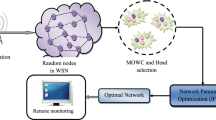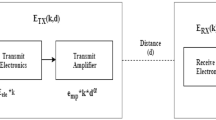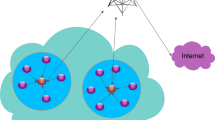Abstract
In wireless sensor networks (WSN), for reliability, load balancing and security reason, various sinks, for the most part, sent for gathering different copies of checking data, which causes high vitality use and network lifetime diminishment. Sensors are in charge of detecting and transferring information, and gateways are furnished with 3G/4G radios and can store the gathered information from sensors incidentally and transmit the information to the remote server farm through a third party correspondence benefit. In this paper, consider remote monitoring center through a third party telecommunication service. For this situation service cost assessment in WSN, the cluster the networks used by possibilistic fuzzy C means clustering strategy and minimize the service cost of network with the help of enhanced krill swarm optimization, create an issue of amplifying network throughput with negligible service cost with a target to expand the measure of information gathered by all passages while limiting the service cost. From that re-imagined network, throughput is ensured with the greatest lifetime and information design in the Airtel network with the least cost. From the simulation analysis, outcome exhibit the proposed algorithm outperforms different algorithm in terms of service cost and performance measures.








Similar content being viewed by others
References
Frezzetti, A., Manfredi, S., & Pagano, M. (2015). A design approach of the solar harvesting control system for wireless sensor node. Journal of Control Engineering Practice, 44, 45–54.
Chena, X., & Roweb, N. (2013). Energy-efficient communication in wireless cable sensor networks. Journal of Parallel, Emergent and Distributed Systems, 28(4), 289–307.
Shimura, M., Kitahara, H. K. H., Kobayashi, H., & Okamot, S. (2004). Radiation area monitoring by wireless-communicating area monitor with surveillance camera. Journal of Nuclear Science and Technology, 41(4), 271–274.
Bhatt, U. R., Chouhan, N., & Upadhyay, R. (2015). Hybrid algorithm: A cost efficient solution for ONU placement in fiber-wireless (FiWi) network. Journal of Optical Fiber Technology, 22, 76–83.
Gagneja, K. K. (2015). Secure communication scheme for wireless sensor networks to maintain anonymity. In Proceedings of the computing, networking and communications (ICNC), IEEE international conference (pp. 1142–1147), Garden Grove, CA.
Demers, F., Yanikomeroglu, H., & St-Hilaire, M. (2011). A survey of opportunities for free space optics in next generation cellular networks. In Ninth annual proceedings of communication networks and services research conference (CNSR) (pp. 210–216). Ottawa: IEEE.
Li, Y., Pappas, N., Angelakis, V., Píoro, M., & Yuan, D. (2014). Optimization of free space optical wireless network for cellular backhauling (pp. 1406–2480), arXiv preprint.
Jain, N., & Agrawal, D. (2005). Current trends in wireless sensor network design. Journal of Distributed Sensor Networks, 1, 101–122.
Yildiz, H. U., Bicakci, K., Tavli, B., Gultekin, H., & Incebacak, D. (2016). Maximizing wireless sensor network lifetime by communication/computation energy optimization of non-repudiation security service: Node level versus network level strategies. Ad Hoc Networks, 37, 301–323.
Ling, N., & Mei-Xia, D. (2015). Design of a remote data monitoring system based on sensor network. Journal of Smart Home, 9(5), 23–30.
Gandhi, A., Harchol-Balter, M., Das, R., & Lefurgy, C. (2009). Optimal power allocation in server farms. Journal of ACM Sigmetrics Performance Evaluation Review, 37(1), 157–168.
Gandhi, A., Gupta, V., Harchol-Balter, M., & Kozuch, M. (2011). Optimality analysis of energy-performance trade-off for server farm management. Journal of Performance Evaluation, 67, 1155–1171.
Guo, Y, Ding, Z, Fang, Y., & Wu, D. (2010). Cutting down electricity cost in internet data centers by using energy storage. In 2011 IEEE proceedings of the global telecommunications conference (GLOBECOM 2011) (pp. 1–5), Houston.
Xu, Z., & Liang, W. (2015). Operational cost minimization of distributed data centers through the provision of fair request rate allocations while meeting different user SLAs. Computer Networks, 83, 59–75.
Gao, D., Lin, H., & Liu, X. (2016). Routing protocol for k-anycast communication in rechargeable wireless sensor networks. Journal of Computer Standards & Interfaces, 43, 12–20.
Marina, M., & Das, S. (2006). Ad hoc on-demand multipath distance vector routing. Journal of Wireless Communications and Mobile Computing, 6(7), 969–988.
Sun, X., Chen, H., Wu, X., Yin, X., & Song, W. (2016). Opportunistic communications based on distributed width-controllable braided multipath routing in wireless sensor networks. Ad Hoc Networks, 36, 349–367.
Bade, M., Toycan, M., & Walker, S. (2015). Cost and energy efficient operation of converged, reconfigurable optical wireless networks. Journal of Optical Switching and Networking, 18, 71–80.
Plotnikov, E., et al. (2015). Using VNS for the optimal synthesis of the communication tree in wireless sensor networks. Journal of Electronic Notes in Discrete Mathematics, 47, 21–28.
Kliks, A., Pérez-Romero, J., Boukhatem, L., & Zalonis, A. (2015). Technical advances in the design and deployment of future heterogeneous networks. Journal on Wireless Communications and Networking, 1, 1–5.
Lin, H.-F., & Huang, Y.-W. (2015). Factors affecting passenger choice of low cost carriers: An analytic network process approach. Journal of Tourism Management Perspectives, 16, 1–10.
Viswanath, S., Belcastro, M., Barton, J., O’Flynn, B., Holmes, N., & Dixon, P. (2015). Low-power wireless liquid monitoring system using ultrasonic sensors. Journal on Smart Sensing & Intelligent Systems, 8(1), 26–44.
Xu, X., Liang, W., & Xu, Z. (2014). Remote monitoring cost minimization for an unreliable sensor network with guaranteed network throughput. Journal of Information Processing in Agriculture, 1(2), 83–94.
Author information
Authors and Affiliations
Corresponding author
Additional information
Publisher's Note
Springer Nature remains neutral with regard to jurisdictional claims in published maps and institutional affiliations.
Rights and permissions
About this article
Cite this article
Thekkil, T.M., Prabakaran, N. Minimizing Remote Monitoring Service Cost of Wireless Sensor Networks Using Krill Swarm Optimization. Wireless Pers Commun 109, 1429–1448 (2019). https://doi.org/10.1007/s11277-019-06620-7
Published:
Issue Date:
DOI: https://doi.org/10.1007/s11277-019-06620-7




